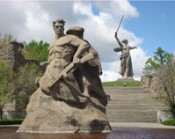
Historical significance of the Battle of Stalingrad disclosed in the Presidential Library collections
To mark the 72nd anniversary of the beginning of the Battle of Stalingrad, the Presidential Library published on the website new materials revealing its importance for the outcome of the war and heroism of the city defenders. The collection includes rare books, memories of participants of the events, copies of digitized newspapers, as well as maps and posters of wartime.
The digital copy of Alexander Samsonov’s "The Battle of Stalingrad" shows the correlation of forces on the eve of an unprecedented battle on the Volga, cites memories of our soldiers and commanders, recreating realities of this confrontation and showing the origins of the moral superiority of people liberating the country from Nazi invasion.
The 6th Field Army, under the command of Colonel-General Paulus of the Group "B" Wehrmacht Armies was assigned to capture Stalingrad. The German command planned to seize the city July 25, 1942.
Soviet troops in this sector were part of the Stalingrad Front. In the beginning, it included four field armies, and later their number had increased to eight.
By tasks, spatial scale and time scale the Battle of Stalingrad comprises two stages: July 17 - November 18, 1942 - defensive operation; November 19, 1942 - February 2, 1943 – offensive one. Samsonov’s book gives the exhaustive characteristics of the first phase of the impending battle: "Defensive battle at Stalingrad was composed of hundreds of thousands of combat episodes. Their participants often ascribed to them independent of operational importance. One of such fights was described byProfessor, Doctor of Technical Sciences, I. V. Kotlyar from Gorky, who sent a copy of an article written by him for a local newspaper:
"August 20-21, the remains of our 1186 anti-fighter regiment, after heavy fighting first on the west and then on the east bank of the Don, were backed to the rear, to the northern outskirts of Stalingrad to replenish them with men and equipment. Meanwhile, the enemy was preparing for a decisive offensive, threatening to seize the tractor factory... We met Germans with intense fire ... The battle lasted until the evening, and at night the Germans retreated. We won the time. August 24, a militia battalion, formed mainly of workers of the tractor factory and other units joined us."
Further, the author writes: "In the afternoon, August 23, shock troops of Paulus’ army reached the Volga. Ahead were the long days and nights of fierce fighting for Stalingrad, for its every street, every house. In those days we did not know that maybe be the fighting north to the tractor factory was the first one of the great battle for the city on the Volga, the battle that marked the beginning of our victory."
The documentary film "The Battle of Stalingrad. Defense of Stalingrad" available on the Presidential Library website and consisting of war newsreel, shows unique visuals: soldiers running in the ruined city, urban combats going on, the commander of the Stalingrad Front, Colonel-General Eremenko leaning over the map, guns are firing... Offscreen text: "Soldiers in Stalingrad took an oath: "Standing to death!" "Beyond the Volga there is no land for us!" And they kept their oath. Here is what the commander of the Stalingrad Front Colonel-General Eremenko said: "The Battle of Stalingrad is unparalleled in the history of battles due to 90 days of continuous attacks and to the introduction of military equipment. Such a battle occurs once in a lifetime. For three months in a row the enemy has been attacking the Stalingrad stronghold. But the proud soldiers of Stalingrad are inflexible in their will to defend Stalingrad.'"
Digital copy of the newspaper "Stalingrad Pravda" from August 28, 1943 reflects the offensive phase of the operation, where the mood of the soldiers was more cheerful:
"Let all my comrades know, writes in the article "We are all Stalingrad citizens" a sniper guard Ivan Gordienko, that the former Stakhanovist defends his homeland with a rifle in his hands, that he fights for his native city of Stalingrad.
Comrades! I am Ukrainian myself, my native town is Mariupol. We will not forgive the Germans a single stone, a single trampled tree in my Ukrainian city like we never forgave the Germans a single brick broken by them in Stalingrad. We guys, no matter where we were born, no matter what nationality we are, call ourselves Stalingrad citizens...
With fervent faith in our victory. Sniper Guard - Ivan Gordienko."
The Battle of Stalingrad was the greatest turning point in the Second World War. Hitler's Germany was shaken to its foundations by the crushing blow. Victory was still far away, but the course toward it was taken.
Historical documents describing the victory of the Soviet people in the Great Patriotic War, are brough together in the collection, "Memory of the Great Victory" available on the Presidential Library website; today it includes more than 20,000 items.

